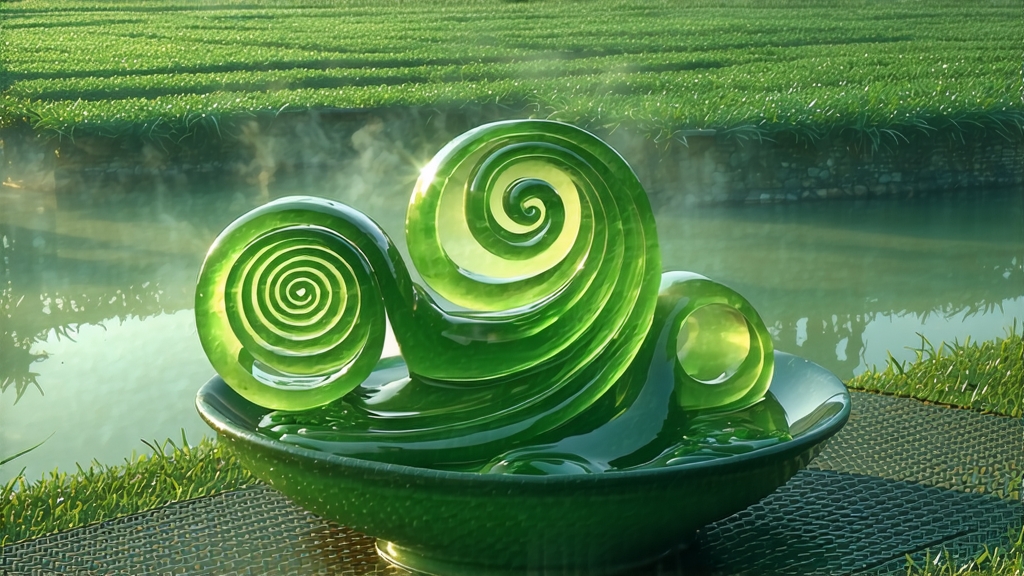
Biluochun, whose name translates literally to “Green Snail Spring,” is one of China’s ten most celebrated teas, yet it remains a quiet legend outside the circles of serious connoisseurs. Produced only in a micro-zone around Taihu Lake in Jiangsu Province, this tea carries the perfume of apricot blossoms and the mineral breath of limestone cliffs in every downy curl. Its history, processing, and even the way it is coaxed into a cup form a narrative that mirrors the gentle turning of Jiangnan’s seasons.
Historical whispers place Biluochun’s birth during the late Tang dynasty, when monks on Dongting Mountain began pan-firing wild tea shoots that grew interlaced with peach, plum, and apricot trees. The fruit trees flowered early, and the tender tea leaves absorbed their fragrance, giving rise to the tea’s signature floral aroma. By the Kangxi era of the Qing dynasty, the emperor—traveling incognito south of the Yangtze—was served a cup of this unusual tea. Struck by its vivid jade color and snail-like shape, he christened it “Biluochun,” replacing its humbler market name “Xia Sha Ren Xiang,” literally “Scary Fragrance,” because farmers joked its perfume was almost frighteningly strong.
Strictly speaking, only leaves picked within a 12-kilometer radius of Dongting’s East and West mountains can claim the protected designation Biluochun. Even inside this radius, three grades exist: Supreme, Special, and Grade One. Supreme is harvested before the Qingming festival, when only the unopened bud plus one adjacent leaf is plucked before dawn while dew still clings. Special grade follows a week later, allowing a bud and two leaves, while Grade One is gathered before the Grain Rain. The tiny harvest window—barely fifteen days—explains why authentic Biluochun can cost more per gram than silver.
The craft begins the moment pickers descend the terraces at daybreak. Leaves are deposited in shallow bamboo baskets no deeper than five centimeters to prevent bruising. Back at the cottage, the withering stage is skipped entirely; instead, the leaves are immediately “sha qing” or kill-green in a wok heated to exactly 180 °C. A single batch never exceeds 250 g—any more and the master’s wrist cannot flick fast enough to prevent scorching. For three to four minutes the leaves are tossed, pressed, and rolled against the iron surface until they emit a faint popcorn note. The temperature is then dropped to 70 °C, and the true shaping begins. Using only the heel of the palm, the tea maker applies a delicate spiral motion, coaxing each bud into a tight whorl that will later resemble a miniature snail shell. During this stage, white down emerges prominently, a sign of amino acid richness. Finally, the coils are dried at 60 °C for thirty minutes, reducing moisture to five percent while locking in the downy sheen. The entire process, from tree to finished tea, must finish within four hours; otherwise, the enzymatic edge is lost and the fragrance collapses.
Brewing Biluochun is an exercise in restraint. A 200 ml glass is preferable because it allows the spirals to unfurl vertically, a performance known as “tea dancing.” Water should be 75 °C—any hotter and the down dissolves, turning the liquor cloudy and bitter. Use three grams of leaf, rinsing them briefly with 30 ml of water to awaken the aroma. Discard the rinse, then fill the glass to one-third capacity, letting the leaves sink. After thirty seconds, top up with water to the rim. The first infusion, pale jade with a silvery meniscus, delivers notes of white peach and fresh chestnut. Second infusion at forty-five seconds intensifies the nectarine sweetness, while the third, at one minute, reveals a mineral finish reminiscent of wet slate. Most leaves surrender their full flavor within three steeps, a hallmark of early-spring pluck.
Tasting Biluochun is best done in silence. Bring the cup to the nose first; a quality batch will release a vertical bouquet that rises in three tiers: top notes of apricot blossom, mid notes of honeydew, and a bass note of steamed edamame. On the palate, the liquor should feel weightless yet creamy, a texture Chinese sommeliers call “yun,” loosely translated as lingering charm. Swish the tea gently across the tongue; if you detect a faint tingling at the back of the throat, similar to the effervescence of